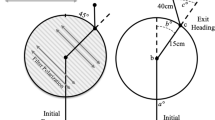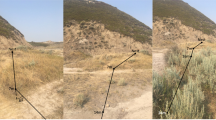Abstract
Camponotus pennsylvanicus(DeGeer) and Tapinoma sessile(Say) exploit structural elements as guide-lines in their topographic orientation. This research documents the response of T. sessileand C. pennsylvanicusto a series of thigmotactic, gravitational, chemotactic, and phototactic cues while utilizing structural guidelines. Adherence to these guidelines is more pronounced on vertical than on horizontal surfaces and more pronounced in darkness than in daylight. Orientation switches from a crestline on the horizontal to a groove on the vertical. Light and odor trails serve an important role as distance cues in structural guideline orientation. The hierarchy of orientation cues and the adaptive significance of these ant's exploitation of structural guidelines are discussed.
Similar content being viewed by others
References
Bell, W. J., and Adiyodi, K. G. (1981).The American Cockroach, Chapman and Hall, New York.
Berthold, R., Jr., and Wilson, B. R. (1967). Resting behavior of the German cockroach,Blattella germanica (L.).Ann. Entomol. Soc. Am. 60: 347–351.
Bonnet, C. (1779). Observation XLIII. Sur procede des fourmis.Deuvres Hist. Nat. Philos. 1: 535–536.
Burns, D. P. (1973). The foraging and tending behavior ofDolichoderus taschenbergi (Hymenoptera: Formicidae).Can. Entomol. 105: 97–104.
Hansen, L. D., and Akre, R. D. (1990). Biology of carpenter ants. In Vander Meer, R. K., Jaffe, K., and Cedeno, A. (eds.),Applied Myrmecology, Westview Press, Boulder, Colo., pp. 274–280.
Harada, A. Y. (1990). Ant pests of the Tapinomini tribe. In Vander Meer, R. K., Jaffe, K., and Cedeno, A. (eds.),Applied Myrmecology, Westview Press, Boulder, Colo., pp. 298–315.
Hollander, M., and Wolfe, D. A. (1973).Nonparametric Statistical Methods, John Wiley & Sons, New York.
Jander, R. (1957). Die optische Richtungsorientierung der Roten Waldameise(Formica rufa L.).Z. Vergleichende Physiol 40: 162–238.
Jander, R. (1977). Orientation ecology. In Grzimek, B. (ed.),Encyclopedia of Ethology, Van Nostrand Reinhold, New York. pp. 145–163.
Jander, R. (1990). Arboreal search in ants: Search on branches (Hymenoptera: Formicidae).J. Insect Behav. 3: 515–527.
Jander, R., and Daumer, K. (1974). Guide-line and gravity orientation of blind termites foraging in the open (Termitidae:Macrotermes, Hospitalitermes).Insectes Soc. 21: 45–69.
Klotz, J. H. (1984). Diel differences in foraging in two ant species (Hymenoptera: Formicidae).J. Kans. Entomol. Soc. 57: 111–118.
Klotz, J. H. (1986). Topographic orientation in two species of ants (Hymenoptera: Formicidae).Insectes Soc. 34: 236–251.
Klotz, J. H., Cole, S. L., and Kuhns, H. R. (1985). Crest-line orientation inCamponotus pennsylvanicus (DeGeer).Insectes Soc. 32: 305–312.
SAS Institute (1990).SAS Procedures Guide, SAS Institute, Cary, N.C.
Schone, H. (1984).Spatial Orientation, Princeton University Press, Princeton, N.J.
Topoff, H., and Lawson, K. (1979). Orientation of the army antNeivamyrmex nigrescens: Integration of chemical and tactile information.Anim. Behav. 27: 429–433.
Author information
Authors and Affiliations
Rights and permissions
About this article
Cite this article
Klotz, J.H., Reid, B.L. The use of spatial cues for structural guideline orientation inTapinoma sessile andCamponotus pennsylvanicus (Hymenoptera: Formicidae). J Insect Behav 5, 71–82 (1992). https://doi.org/10.1007/BF01049159
Accepted:
Issue Date:
DOI: https://doi.org/10.1007/BF01049159




